The History Of Scion

Scion is a marque of vehicles produced by Toyota Motor Corporation for the North American market. Founded in 2002, Scion's long-term goal is to appeal to Generation Y consumers. The first Scion models, the xA hatchback and xB wagon, went on sale in California in 2003, followed by a sports coupe, the tC, and a nationwide U.S. launch in 2004. A successor to the xA, the xD, premiered in 2008, and the Scion marque expanded to Canada in 2010. The Scion lineup uses a one-trim, simplified purchase process, and the marque has relied upon guerrilla and viral marketing techniques. The Scion name, meaning the descendant of a family or heir, refers both to the marque's cars and their owners.
In 1999, Toyota launched Project Genesis, an effort to bring younger buyers to the Toyota marque in the United States. This project aimed to create a "marque within a marque" in sales and advertising strategy for compact and coupe models sold by Toyota. The effort, which included the introduction of the Toyota Echo economy car, along with late generation Toyota MR-2 and Toyota Celica models, was judged unsuccessful and cancelled in 2001. In response, Toyota chose to launch a separate marque, an effort called Project Exodus. This project became known as Scion.
Scion was first introduced in March 2002, at the New York Auto Show. There were just two concept vehicles, the bbX (which was to become the xB), and the ccX, which was to become the tC. The 2004 xA and xB were unveiled at the Greater Los Angeles Auto Show on January 2, 2003. They were available only in 105 Toyota dealerships in California at their initial launch on June 6, 2003. The subsequent rollout of the brand to the South, the Southeast, and the East Coast occurred in February 2004. Scion vehicles were available nationwide in June 2004, coinciding with the release of the 2005 tC. On December 16, 2006, Scion unveiled the next-generation xB, based on the t2B concept, and the new xD, successor of the xA, at an invitation-only, no-camera event in Miami. Both cars were then publicly unveiled on February 8, 2007 at the 2007 Chicago Auto Show.
Scion stems from Toyota's well publicized use of "Value Innovation", a series of articles in Harvard Business Review later encapsulated in the book Blue Ocean Strategy. Key factors of Toyota's strategy canvas were never published but include "Price," "Factor Options," "Performance driving metrics," "Confidence in buying," "21st Century Radio."
Toyota Canada Inc. announced that the Scion brand will be available in September of 2010 at 45 selected dealers starting in Toronto, Montreal, and Vancouver, followed by other cities. Launch models include tC, xD, xB. The Toyota IQ shown in Tokyo will come to Canada as a Scion model in 2011 as a 2012 model. The first new Scions were shown in Canada at the 2009 Montreal International Auto Show.
Scion currently has three models: tC, a 3-door liftback based on the European-marketed Toyota Avensis; the second-generation xB, a 5-door box-shaped compact wagon sold as the Toyota Corolla Rumion in the Japanese market; and the xD, a 5 door-subcompact car that is sold as the Toyota ist in Japan, which is based on the Yaris 4 door platform with the 2009 Toyota Corolla's engine.
- Scion xA 2003-2006
- Scion xB 2003-current
- Generation 1: 2003-2006
- Generation 2: 2008-current
- Scion tC 2004-current
- Scion xD 2008-current
Scion uses sales tools such as "Pure Price" and monospec trim levels with a wide selection of factory and TRD accessories. Extensive market research and testing with Generation Y consumers formed the basis of the Scion badge.
"Pure Price" means that the price posted, whether on the vehicle, in an advertisement, or on a menu display board in the dealership, is the price customers will pay. This includes vehicles, accessories, finance and insurance products. Pure Price is designed to ensure a shorter and simpler process, eliminating all negotiation. The concept aims to be open and consistent to all customers. The concept is not new to the American market, having been introduced in the early 1990s by the Geo and Saturn marques of General Motors.
Scion's sales approach thus differs greatly from that of the larger Toyota entity. In the United States, for instance, the Toyota Camry offers several trim levels: the Camry grade CE "Classic Edition" (for budget-conscious drivers), LE "Luxury Edition" (popularly equipped), SE "Special Edition" (for sporty drivers), and XLE "Extra Luxury Edition" (for luxury-minded drivers). In contrast, all Scions have one standard trim level (monospec) and are designed to be uniquely customized for the driver.
Scion offers about 40 different accessories; other after-market companies through the Optimize Scion program offer to add other accessories, as well. For example, one can add a subwoofer as well as different types of decals. The tC had offered an optional supercharger to increase power from 161 to 200hp (120 to 150kW), but this option was since discontinued in 2007. All accessories are sold individually, and do not require special packages. However, some options, such as Ground Effects, do prevent other accessories (such as mud flaps) from being installed.
Companies that participate in the Optimize Scion program include GReddy, OBX, RÄZO, a few car detailing companies, and others.
Beginning in late spring 2004 with the launch of the 2004 Scion xB RS 1.0 (Release Series 1.0), followed by the Scion xA RS 1.0, Scion decided to create limited edition vehicles pre-packaged with exclusive accessories in limited quantities. Limited Edition vehicles from a marketing standpoint were used to create a buzz for the brand name, with their exterior colors tending to be loud or bright hues (e.g. orange, yellow, red, blue, green). Because of the growing popularity of the Scion product line and the scarce production runs (most dealers only get 2-3 of each RS model), these limited edition vehicles quickly sell out. Pre-ordering is available at each dealership on a first-come, first-served basis. To the customer's benefit, Scion's "Pure Price" MSRP bounds dealerships against market-demand vehicle mark-up. Naturally, resale values of Release Series vehicles command a premium because of their packaged options and scarcity.
2004
- xB RS 1.0 only available in Hot Lava Orange with 2100 units produced (504 units w/ 5spd, 1596 units w/ automatic)
- xA RS 1.0 only available in Absolutely Red with 1550 units produced
2005
- xB RS 2.0 only available in Solar Yellow with 2500 units produced
- xA RS 2.0 only available in Spectra Blue Mica with 1700 units produced
- tC RS 1.0 only available in Absolutely Red with 2500 units produced
2006
- xB RS 3.0 only available in Envy Green with 2200 units produced
- xA RS 3.0 only available in Stingray Metallic light blue with 2500 units produced
- tC RS 2.0 only available in Blue Blitz Mica with 2600 units produced
- xB RS 4.0 only available in Maziora Torched Penny (polarized goldish brown) with 2500 units produced
2007
- tC RS 3.0 only available in Blizzard White with 2500 units produced
2008
- xB RS 5.0 only available in Gold Rush Mica with 2500 units produced
- tC RS 4.0 only available in Galactic Gray Mica with 2300 units produced
- xD RS 1.0 only available in Hot Lava Orange with 2000 units produced
2009
- xB RS 6.0 only available in Absolutely Red with 2500 units produced
- tC RS 5.0 only available in Gloss Black with 2000 units produced
- xD RS 2.0 only available in Wasabi Green with 2000 units produced
2010
- xB RS 7.0 only available in Murasaki Purple with 2000 units produced
- tC RS 6.0 only available in Speedway Blue with 1100 units produced
The median age of a Toyota consumer was, as of February 2007, 54 years old. Comparatively, Scion's average buyer age is the lowest in the industry, at 39 years old.
Scion's first two cars (the xA and xB), while unusual for American roads, have been well received among consumers not interested in standard entry-level vehicles. The tC was also well received with brisk sales.
To advertise Scion, Toyota began a new campaign for the Scion using a form of guerrilla marketing, using posters and ads in movie theaters and TV to direct consumers to the sites, want2bsquare.org, want2bsquare.tv, and want2bsquare.info. Scion's marketing endeavors extended to sponsorships, such as that of VBS.tv's show, Thumbs Up!, which features David Choe hitchhiking across the United States. Scion sponsored two commercials featuring Concours race car driver Matt Verbin during the Castle Hill Concours d'Elegance which show him racing a custom painted yellow and orange xB on Cambridge streets. Scion has also teamed up with Gaia Online, providing the xB as a choice for user car, as well as other things across the site.
Scion also uses smaller, regional viral campaigns to reach smaller demographics. Online campaigns like http://www.scionxpressionism.com allow the user to modify and design his own Scion with graphics, decals, and aftermarket car parts. Scion is also currently running its own viral-marketing website Scion bB, to promote other artists and events that it sponsors. Shows like Slick's Picks go around the country interviewing artists, stores, and events; and puts short videos on the site. Scion Radio 17 is an internet-radio initiative which features 17 non-mainstream channels, ranging from rock and hip hop to electro and soul.
In August 2008, Scion released its newest ad campaign, "United by Individuality", featuring over 300 Scion owners' vehicles in various magazine articles, commercials, and billboards. The latest commercial video shows a convoy of Scions parading through the desert in Boulder City, Nevada. These videos and ads can be seen on Scion's website at scion.com/ scionunited.
There is a strong base of clubs and organizations associated with the Scion brand used to exchange information and to plan Scion related events. Five major online communities include www.scionlife.com, www.itsmyscion.com, www.scikotics.com, www.scionevolution.org, & www.scionimage.net. Also blogs exist dedicated to scion like Dealerfun.net.
In February 2009 Scion founded a monthly podcast called the "Scion A/ V Podcast" located at http://scionpodcasts.podbean.com/ . The Scion A/ V podcast series presents exclusive artist interviews, event coverage, and info about upcoming events & releases.
From Wikipedia, the free encyclopedia
More About Scion
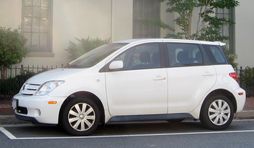
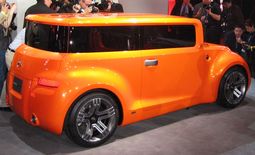
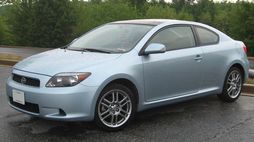
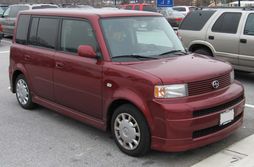
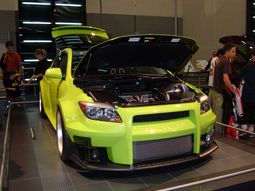
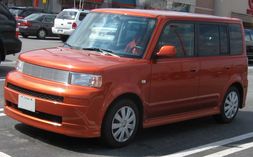
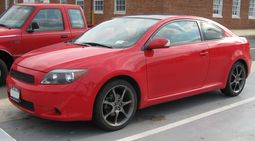
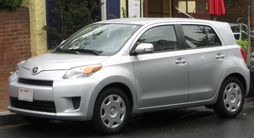
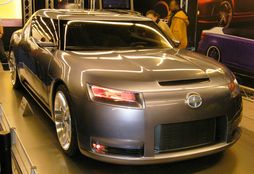
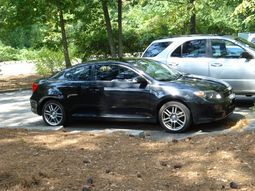
|